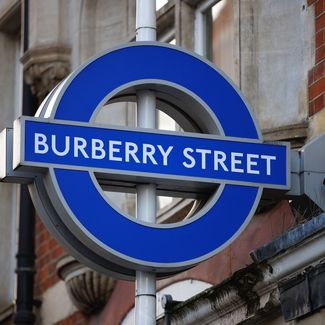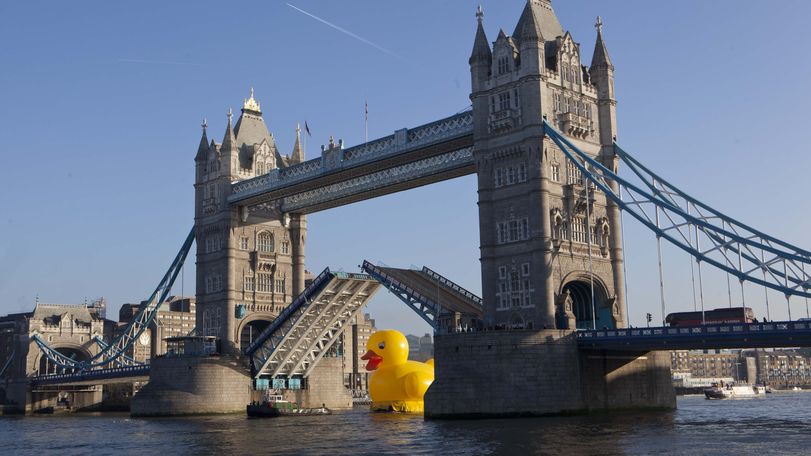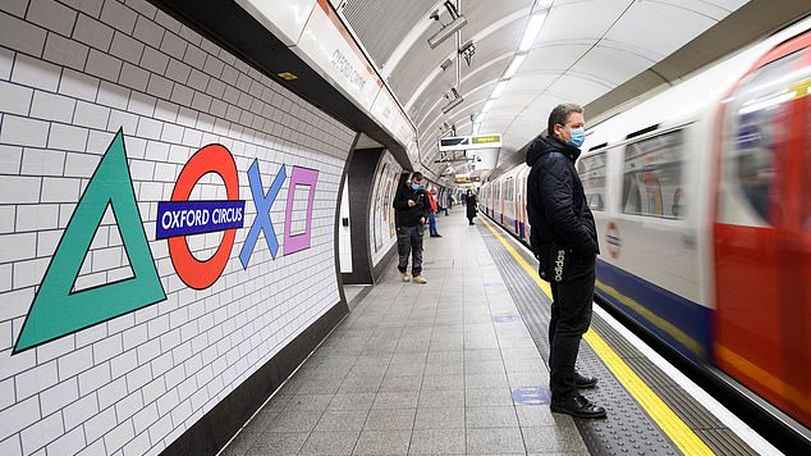
Question Of The Week
Was "Burberry Street" a brand activation too far?
The industry reacts to the London Fashion Week stunt that saw Bond Street tube station renamed after the fashion brand
26 September 2023
For London Fashion Week, the bougiest central London Underground Tube Station had a fashionable makeover. Bond Street was revamped as Burberry Street for the duration of the show.
The campaign heralded the opening of Burberry’s redesigned flagship store on Bond Street, and featured 'knight blue', a colour debuted by Burberry's chief creative officer Daniel Lee.
However it didn't receive universal acclaim - some unsuspecting travellers were in a state of confusion at the stunt. In particular it was called out for being poorly worded, while other critics objected to its corporatisation of a public space.
Although there was a spike in Google searches for "Burberry", and the campaign garnered a lot of social media attention, the fact that it irritated some raise questions over whether it was worth it. TfL refused to comment on how much they made from the deal but assured that it would be reinvested into the network.
This was not the first time TfL has altered the names of stations (Barbie-can, Webminister), and is unlikely to be the last. After all, at Cannes this year, the Grand Prix For Good was awarded to Havas Paris for their work with Foundation Anne de Gaulle that saw the renaming of Paris' international airport for a whole week.
Nonetheless the question facing brands and agencies now is should public spaces be branded when they have the potential to irritate or confuse. With consumer utility affected, is the danger of backlash worth carrying out such stunts?
We asked the industry their opinions.
Sue Unerman, chief transformation officer, EssenceMediacomX and global head of relevance, EssenceMediacom Creative Futures
Wouldn’t it have been great if the Burberry check had been used for the station name? Maybe this would have been less confusing too (although maximum confusion was for tourists I would guess not regular commuters.)
A high impact brand activation is a really good way of getting a brand talked about. A good brand activation will reflect the brand’s values and help deliver meaning. It isn’t brand activations that annoy people, its ad bombardment (new research from the Ad Association shows this as the number one cause of distrust in ads). The number one and two reasons to improve trust are enjoyment/entertainment and social contribution. Get it right, and a brand activation can step change salience and help to grow the brand.
Gen Kobayashi, chief strategy officer, EMEA, Weber Shandwick
I think this all comes down to the quality of execution. There has understandably been some backlash on the renaming of Bond Street station to ‘Burberry Street’. There have been cases of confused passengers wandering around lost looking for their destination or confused and worried they’ve missed their stop. And this confusion wasn’t just felt by tourists but by regular commuters on their autopilot journey to work. And I think this all comes down to the quality of execution. The difference between ‘Burberry Street’ and ‘Barbiecan’ is obvious, one has subtly made wordplay work for entertainment purposes and the other is a pun that is having to work so hard that it’s just confusing.
Executions like this are only valuable if they do what they’re intended, which is to put a smile on your face momentarily or make you feel included in an inside joke. Burberry seems to have missed the point and inadvertently turned a poorly executed idea into a point of frustration versus contributing any sort of value.
Kate Nettleton, head of planning, VMLY&R
I worked on TfL. I love the brand. It’s iconic. The Johnston typeface is one of the most enduring examples of corporate branding there is. So, it’s no surprise that brands want to borrow some of this minimalistic mojo. To steal a smidgen of the equity that drips from the design totem that is the prestigious ‘roundel’.
But I’d argue it’s use for these kinds of branded take overs need to be handled very carefully. These are the crown jewels of the UK’s iconographic brand assets. Only the smartest, most culturally befitting and well thought through ‘takeovers’ need apply in my mind. But it seems that a few too many are slipping through the net. Surely a brand like TfL deserves something a little more than a paltry pun and some Johnston jiggery?
I’m less concerned about the wondering masses who can’t find the right exit for Selfridges. And more concerned that brands like TfL need to be more protective and selective about who they let play with their crown jewels.
Ben Jaffe, chief strategy officer, FCB London
Setting aside the polemic on corporate creep, I think Burberry’s takeover of Bond Street is a heavy-handed execution of its otherwise brilliantly jarring approach to branding.
Against the ongoing march of widely kerned wordmarks, Andy Lee has reintroduced a proudly serifed typeface, accompanied with the flourish of Burberry’s historic picture mark, the “Equestrian Knight” and the unashamed use of an actual colour. The application of Burberry’s branding is brilliantly awkward. It doesn’t sit politely in the bottom right-hand corner of layouts, it’s stamped across images of models, clothing and landmarks as a proprietary… branding device. Burberry stands out, it makes you look, it makes you think, and it makes you spend time with its product and style. I reckon that’s good branding; simply replacing the name of a tube station with your brand name isn’t.
Matt Walters, planning partner, New Commercial Arts
Disruption is what makes ideas like this work. And getting it right often comes from a place of audience understanding. Understanding the world they move in in order to subvert or add to it. Understanding their perceptions of, or relationship with, the brand in order to say something that raises a knowing smile. Understanding that quite a lot of people quite like puns. And that a visual one will often clear the ‘notice me’ hurdle so many comms falls at, and provide an image that people might share or write about. Done well the value in these ideas is not just for the brands - a huge rubber duck on the Thames, the PlayStation logo at Oxford St station or an inverted Golden Arch might in small ways, make the everyday a bit more interesting. And in these examples, you can still find the Underground or the Drive Thru.
No one sets out to confuse these ideas or mess with someone’s day. Removing the names from the shirts of England’s football teams during live coverage on behalf of the Alzheimer’s Society was an intentional jolt, but the commentary team and supporting communications explained the point.
Take care to understand how your audience will experience the idea, and adjust accordingly, and you’ll hopefully achieve the right sort of disruption, talked about for all the right reasons.
Mara Dettmann, digital strategy & content lead, BBH
In the eight years since Canada Water (briefly) became “Buxton Water” for the London Marathon, tube station name takeovers have lost much of their novelty – essentially, they’ve become just another out of home placement.
While “Barbie-can” this summer generated mostly positive reactions (never mind that it turned out to be a hoax), “Burberry Street” led to an almost disproportionate amount of vitriol. Commentators one-upped each other with reasons to fault the activation: it flummoxed tourists and even locals; was held up as the latest example of corporate takeovers of public spaces; and generally disrupted people’s commutes.
Still, brands shouldn’t write off transit activations – they continue to provide unique opportunities to engage travellers. Unexpected innovations are the ones that stand out; this includes being genuinely helpful (like Ikea’s paid placements on the tube map) or bringing joy in new ways like PlayStation’s PS5-themed takeover.
And if you’re of the “all PR is good PR” mindset, “Burberry Street” did get people talking: Google search interest in Burberry spiked while TikToks about Burberry Street have 3.4 million cumulative views (and counting).
There’s also scope to take a different approach to “tube takeovers” altogether, especially using digital channels: while many brands launched pop ups for London Fashion Week (to mixed reviews), Mac Cosmetics partnered with pop culture sensation Tube Girl – one of her Mac TikToks already has 2.1 million views – and the NBA has an AR effect which lets people shoot (virtual) hoops on the tube.
Suzanne Barker, strategy partner, AMV BBDO
The point of doing a brand activation is to get noticed, talked about, and drive meaning for the brand. And in terms of getting noticed and talked about, should Burberry care that a few people didn’t like a temporary name change of the tube stop? No. Should TfL have considered that before agreeing to it? Probably. But did this activation add meaning or value for Burberry? No.
At least with Foundation Anne de Gaulle, there was a deeper more symbolic point to make - whereas Burberry was just simply marking the territory of their new store. The bigger question is, why didn’t Burberry do something bigger, better, braver? They followed what’s been done before (tube takeover and pop-up cafe with their partnership with Norman’s).
For such a historic, iconic, legendary brand like Burberry, we should all expect more original ideas. There’s more they could have done with their new signature blue or their equestrian horse - those are two interesting springboards for any creative team. Ultimately, Burberry decided to tap dance around culture…rather than really injecting themselves into modern Britain to drive meaning for the brand.
Ella Britton, strategy director, Total Media
TfL renaming Bond Street ‘Burberry Street’ ahead of Fashion Week was not only incredibly confusing for commuters but also, as commentators on X have noted, sort of a pointless activity. Sure, Bond Street is located in an affluent area and likely to attract fans of the brand, but changing the station’s name when it doesn’t even sound the same, a la 'Barbiecan'…make it make sense!
As articles flood in about the privatisation and branding of public spaces, it's important to acknowledge the issue of relevance and impact. It was disruptive sure… but not in a good way. This type of shoehorning is something that we will increasingly see as brands attempt to stand out from the crowd and try something different. But it's crucial to remember your audience and ask yourself ‘Is this relevant? Does this make sense? And in Burberry’s case ‘Is it going to make people miss their tube stop?’.









